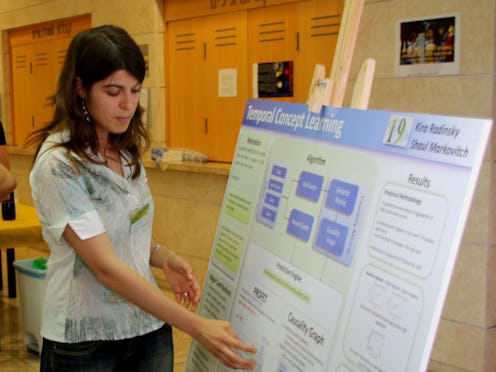News
Can Technology Predict The Future?

This summer, MIT released their exhaustive "35 Innovators Under 35" list: a global celebration of the world's top inventors, whose creations are "poised to have a dramatic impact on the world as we know it." Kira Radisky, the Ukrainian-born researcher who developed a "predictive analytics" system better than any crystal ball, was awarded one of the much-coveted slots.
Radisky's system had predicted events like the "unforeseen" 2012 cholera outbreak in Cuba — the first the country had seen in over a century. Except it wasn't quite unforeseen: Radisky had predicted it months earlier, using software that combed through centuries of data and found a pattern: in poor countries, when a drought occurs after a flood, the result can be cholera. Radisky has now founded SalesPredict, which uses the technology to aid salespeople and major companies. We talked to Radisky to find out more.
Can you tell us a bit about your system for predictive analytics?
My work is inspired by Mark Twain’s quote, who once said: "The past does not repeat itself, but it rhymes."
Although future events have unique circumstances, they typically follow familiar past patterns. Over the past few years, I devoted my life to development of prediction techniques.
My system inferred that Cholera outbreaks in land-locked areas are more likely to occur following storms, especially when preceded by a long drought. Another inference is that genocide events tend to occur following events where local opinion makers describe minority groups as pests. The algorithms I developed deal with the complexity of discovering such patterns.
What kind of algorithm do you use?
My work enables learning about the future by generalizing sequences of historical events extracted from these massive amounts of data points, including 150 years of NYT articles, millions of web searches, and dynamic webpages. Using unstructured, open ontologies (like Wikipedia) my approach models the context-conditional probabilities of potential outcomes. These outcomes can either be provided as input or inferred by the system.
I applied my approach to numerous problems, like predicting disease outbreaks, mortality, and riots. Recent riots in Syria and their locations, for example, were predicted using the learnt pattern: riots are more likely in non-democratic countries with high bread prices and low GDP.
A large-scale empirical evaluation of the system showed that this kind of approach significantly outperforms humans and other common prediction baselines; identifying 30 to 60 percent of upcoming events with 70 to 90 percent accuracy.
What have you been up to recently?
My recent efforts included applying such methods in a diverse array of applications. I worked with Bing to improve web search by predicting changing human information goals, and in my latest venture, I'm predicting future sales of companies and optimizing sales strategies.
Where do you see yourself taking the field of predictive analytics — in other words, what's your biggest hope for the technology?
I believe we can add more science to decision makers — either to economical decision between countries, to disease prevention, and riot prevention. Utilizing our past data to predict future outcomes is not a far future.
I see us taking this technology also to the personal realm as well, For example, analyzing Facebook feeds of teens and trying to predict potential suicide. I believe we can take it even further — by even utilizing our genome data to predict future diseases and by thus predicting them,
Do you think you might go back to the States at some point, or will you stay permanently in Israel [where Radinsky is based]?
Some things are hard to predict!
(Image: Holyrood)